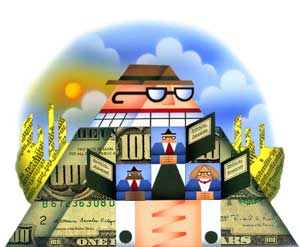|
|
|
 |
|
|
U.S.
Economy >
Monetary & Fiscal Policy |
|
The role of government in the American economy extends far beyond its activities as a regulator of specific industries. The government also manages the overall pace of economic activity, seeking to maintain high levels of employment and stable prices. It has two main tools for achieving these objectives: fiscal policy, through which it determines the appropriate level of taxes and spending; and monetary policy, through which it manages the supply of money. The Federal Reserve, the independent U.S. central bank, manages the money supply and use of credit (monetary policy), while the president and Congress adjust federal spending and taxes (fiscal policy). Since the inflation of the 1970s, Federal Reserve monetary policy has emphasized preventing rapid escalation of general price levels. When the general price level is rising too fast, the Federal Reserve acts to slow economic expansion by reducing the money supply, thus raising short-term interest rates. When the economy is slowing down too fast, or contracting, the Federal Reserve increases the money supply, thus lowering short-term interest rates. The most common way it effects these changes in interest rates, called open-market operations, is by buying and selling government securities among a small group of major banks and bond dealers. A particularly tricky situation for monetary policy makers, called stagflation, occurs when the economy is slowing down and inflation is rising too fast. In 2006 real wages rose 1.7 Percent. This means an extra $1,030 for the typical family of four with two wage earners. Real median household income in the United States climbed between 2005 and 2006, reaching $48,200. The wage growth translates into an extra $585 for the average full-time worker and an extra $1,030 in 2006 for a typical family of four with two workers. The President's Tax Relief enabled more than 5 Million taxpayers, including 4 Million taxpayers with children, to have their income tax liability completely eliminated in 2006. As a result of the President's tax relief, a family with two children now begins to pay income taxes when their income reaches $41,867. Without tax relief, the same family would have begun to pay income taxes when their income reached $33,070.
The President's Tax Relief is helping Americans keep more of what they earn. |
||
| Texts
are abridged from U.S. State Department IIP
publications and other U.S. government materials. |
||
| What
kind of information materials are available?
CD: These documents are available in fulltext format on the About the USA CD-ROM. Teachers: Request a copy for classroom use. L: Selected documents are available in German as well as other languages, including Arabic, Chinese, French, Spanish, Persian and Turkish. |
DISCLAIMER
Any reference obtained from this server to a specific commercial product, process, or service does not constitute or imply an endorsement by the United States Government of the product, process, or service, or its producer or provider. The views and opinions expressed in any referenced document do not necessarily state or reflect those of the United States Government. |

